FairLabor

This project was evaluated and funded by the John S. Latsis foundation as part of the Foundation’s effort to support research teams with all their members being under 40 years old.
The project sought to evaluate farmers' claims that in order to keep market prices at levels consumers are willing to pay and be competitive relative to imported agricultural products, they can’t afford the cost of providing fringe benefits (subsistence wages, reasonable working hours, access to descent housing and personal hygiene facilities, health care services etc.) to the employees. Thus, as they claim, their only option is to settle with illegal employment practices. Questionnaire based surveys were conducted using two popular stated preferences methods (Contingent/Inferred Valuation and Choice experiments) to elicit consumers’ valuation for agricultural products that are certified to ensure fair working conditions (e.g., minimum wage, fair working conditions, decent accommodation) for the workers employed at all production stages. The study found that consumers are willing to pay an average premium of 53 cents of a Euro per 500 g for strawberries with fair labour certification. This result suggests that consumers do value the better treatment of workers in the agricultural sector. It also suggests that there is a current market failure, created by the asymmetry of information between consumers and producers, that can be the basis of discussion for alternative labelling schemes involving fair labour labels.